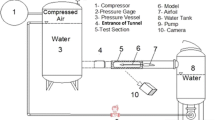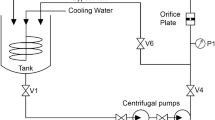Abstract
The primary objective of this research is to study the cavitating effects of fluid flow past different axisymmetric cavitator in the upper sub-critical flow regime, which corresponds to the Reynolds number (2 × 104 to 2 × 105). Experiments are conducted in a water tunnel with a fluid flow velocity of 30 to 60 m/s at a constant rate of injection. The commercial software tool, ANSYS Fluent 18.1, is used to simplify three dimensional Reynolds averaged Navier Stokes equation with the compressible fluid flow by considering the pressure-based solver with standard K- ω turbulence model. The transport equation-based Schnerr and Sauer cavitation model is employed to study the cavitation phenomena. The finite volume discretisation method is implemented to evaluate the cavity length and diameter, respectively. A comparison of the numerical and experimental results shows that the numerical method can predict accurately the shape parameters of the natural cavitation phenomena such as cavity length, cavity diameter, and cavity shape. Results reported that with an increase in velocity, the cavity length and diameter increased to 250 and 20%, respectively. With a decrease in the cavitator angle at constant Reynolds number, the drag coefficient decreases up to 40%. Also, for the 30° cavitator, the drag coefficient rises by 28% when cavitation number is increased from 0.25 to 0.32.















Similar content being viewed by others
Change history
28 September 2022
This article has been retracted. Please see the Retraction Notice for more detail: https://doi.org/10.1007/s40868-022-00119-w
Abbreviations
- A:
-
Area
- D:
-
Diameter
- K:
-
Surface tension
- U:
-
Flow velocity
- P:
-
Pressure
- V:
-
Vapour
- L:
-
Liquid
- G:
-
Non-condensable gas
- Re:
-
Reynolds number
- Fd :
-
Drag force
- Cd :
-
Drag coefficient
- Pc :
-
Cavitation pressure
- \(\sigma\) :
-
Cavitation number
- P∞ :
-
Flow pressure
- Pv :
-
Vapour pressure
- µt :
-
Turbulent viscosity
- µl :
-
Absolute viscosity
- α :
-
Volume fraction
- ρm :
-
Mixture density
- ρ:
-
Water density
- ηo :
-
Bubble number density
- Rb :
-
Bubble radius
- Se :
-
Evaporation source term
- Sc :
-
Condensation source term
- St :
-
Strouhal number
References
R.E. Arndt, Some remarks on hydrofoil cavitation. J. Hydrodyn. 24(3), 305–314 (2012)
J. Kandula, G.S. Kumar, B. Bhasker, Experimental analysis on drag coefficient reduction techniques, in 2016 4th international symposium on environmentally friendly energies and applications (EFEA). (IEEE, New York, 2016), pp. 1–5
X.W. Luo, B. Ji, Y. Tsujimoto, A review of cavitation in hydraulic machinery. J. Hydrodyn. 28(3), 335–358 (2016)
S.K. Gugulothu, Computational modeling on supercavitating flow over axisymmetric cavitators. Ocean Eng. 210, 107515 (2020)
J. Kandula, P.U. Sri, P.R. Reddy, S.K. Gugulothu, Numerical and experimental cavitation assessment of near-wake characteristics of hydrodynamic performance characteristics of cavitating flow with and without ultrasonic transducers. Measurement (2020). https://doi.org/10.1016/j.measurement.2020.108591
H. Feng, Y. Wan, Z. Fan, Numerical investigation of turbulent cavitating flow in an axial flow pump using a new transport-based model. J. Mech. Sci. Technol. 34(2), 745–756 (2020)
P.R. Gogate, A.B. Pandit, Cavitation generation and usage without ultrasound: hydrodynamic cavitation, in Theoretical and experimental sonochemistry involving inorganic systems. (Springer, Dordrecht, 2010), pp. 69–106
F. Bai, K.A. Saalbach, L. Wang, J. Twiefel, Investigation of impact loads caused by ultrasonic cavitation bubbles in small gaps. IEEE Access 6, 64622–64629 (2018)
G. Mancuso, Experimental and numerical investigation on performance of a swirling jet reactor. Ultrason. Sonochem. 49, 241–248 (2018)
B. Huang, S.C. Qiu, X.B. Li, Q. Wu, G.Y. Wang, A review of transient flow structure and unsteady mechanism of cavitating flow. J. Hydrodyn. 31(3), 429–444 (2019)
M. Setareh, M. Saffar-Avval, A. Abdullah, Heat transfer enhancement in an annulus under ultrasound field: a numerical and experimental study. Int. Commun. Heat Mass Transfer 114, 104560 (2020)
X. Zhang, C. Wang, D.W. Wekesa, Numerical and experimental study of pressure-wave formation around an underwater ventilated vehicle. Eur. J. Mech. B 65, 440–449 (2017)
J.B. Carrat, T. Bouvard, R. Fortes-Patella, J.P. Franc, Cavitation aggressiveness on a hydrofoil, in IOP conference series: earth and environmental science, vol. 240, (IOP Publishing, Bristol, 2019), p. 062021
R. Subburaj, P. Khandelwal, S. Vengadesan, Numerical study of flow past an elliptic cylinder near a free surface. Phys. Fluids 30(10), 103603 (2018)
P. Kumar, D. Chatterjee, S. Bakshi, Experimental investigation of cavitating structures in the near wake of a cylinder. Int. J. Multiph. Flow 89, 207–217 (2017)
S.M. Javadpour, S. Farahat, H. Ajam, M. Salari, A.H. Nezhad, Experimental and numerical study of ventilated supercavitation around a cone cavitator. Heat Mass Transf. 53(5), 1491–1502 (2017)
Y. Wang, J. Huang, C. Xu, C. Yu, C. Huang, X. Wu, Experimental and numerical study of the cloud cavitating flow around a slender cylinder with a petals-shaped section, in Fluids engineering division summer meeting, vol. 58080, (American Society of Mechanical Engineers, New York, 2017), p. V002T13A004
C. Negrato, T. Lloyd, T.O.M. Vanterwisga, G. Vaz, R. Bensow, Numerical study of cavitation on a NACA0015 hydrofoil: solution verification, in Proceedings of VII international conference on computational methods in marine engineering, Nantes, French, (2017)
A. Vakil, S.I. Green, Numerical study of two-dimensional circular cylinders in tandem at moderate Reynolds numbers. J. Fluids Eng. (2013). https://doi.org/10.1115/1.4024045
E. Kadivar, M.V. Timoshevskiy, K.S. Pervunin, O. el Moctar, Experimental and numerical study of the cavitation surge passive control around a semi-circular leading-edge flat plate. J. Mar. Sci. Technol. 25(4), 1010–1023 (2020)
M. Atlar, Ö. Gören, Effect of turbulence modelling on the computation of the near-wake flow of a circular cylinder. Ocean Eng. 37(4), 387–399 (2010)
B. Ye, Y. Wang, C. Huang, J. Huang, Numerical study of the pressure wave-induced shedding mechanism in the cavitating flow around an axisymmetric projectile via a compressible multiphase solver. Ocean Eng. 187, 106179 (2019)
H. Djeridi, M. Braza, R. Perrin, G. Harran, E. Cid, S. Cazin, Near-wake turbulence properties around a circular cylinder at high Reynolds number. Flow Turbul. Combust. 71(1–4), 19–34 (2003)
A. Gnanaskandan, K. Mahesh, Numerical investigation of near-wake characteristics of cavitating flow over a circular cylinder. J. Fluid Mech. 790, 453–491 (2016)
Q. Qin, C.C. Song, R.E. Arndt, A numerical study of the unsteady turbulent wake behind a cavitating hydrofoil. Bull Am Phys Soc 48(10), 107 (2003)
F.L. Brandao, M. Bhatt, K. Mahesh, Numerical study of cavitation regimes in flow over a circular cylinder. J. Fluid Mech. (2020). https://doi.org/10.1017/jfm.2019.971
E. Ghahramani, S. Jahangir, M. Neuhauser, S. Bourgeois, C. Poelma, R.E. Bensow, Experimental and numerical study of cavitating flow around a surface mounted semi-circular cylinder. Int. J. Multiph. Flow 124, 103191 (2020)
Y. Long, X. Long, B. Ji, LES investigation of cavitating flows around a sphere with special emphasis on the cavitation–vortex interactions. Acta Mech. Sin. (2020). https://doi.org/10.1007/s10409-020-01008-4
B. Ji, X.W. Luo, R.E. Arndt, X. Peng, Y. Wu, Large eddy simulation and theoretical investigations of the transient cavitating vortical flow structure around a NACA66 hydrofoil. Int. J. Multiph. Flow 68, 121–134 (2015)
B. Ji, X. Luo, R.E. Arndt, Y. Wu, Numerical simulation of three-dimensional cavitation shedding dynamics with special emphasis on cavitation–vortex interaction. Ocean Eng. 87, 64–77 (2014)
H. Cheng, X. Long, B. Ji, X. Peng, M. Farhat, A new Euler-Lagrangian cavitation model for tip-vortex cavitation with the effect of non-condensable gas. Int. J. Multiph. Flow 134, 103441 (2020)
H.Y. Cheng, X.R. Bai, X.P. Long, B. Ji, X.X. Peng, M. Farhat, Large eddy simulation of the tip-leakage cavitating flow with an insight on how cavitation influences vorticity and turbulence. Appl. Math. Model. 77, 788–809 (2020)
M. Javadpour, S. Farahat, H. Ajam, M. Salari, A.H. Nezhad, An experimental and numerical study of supercavitating flows tric cavitators. J. Theor. Appl. Mech. 54(3), 795–810 (2016)
F. Menter, Zonal two equation kw turbulence models for aerodynamic flows, in 23rd fluid dynamics, plasmadynamics, and lasers conference. (IEEE, New York, 1993), p. 2906
J.I. Bin, X.W. Luo, X.X. Peng, Y. Zhang, Y.L. Wu, H.Y. Xu, Numerical investigation of the ventilated cavitating flow around an under-water vehicle based on a three-component cavitation model. J. Hydrodyn. B 22(6), 753–759 (2010)
Z.R. Li, M. Pourquie, T.J. Van Terwisga, A numerical study of steady and unsteady cavitation on a 2d hydrofoil. J. Hydrodyn. 22(1), 728–735 (2010)
J.J. Zhou, K.P. Yu, J.X. Min, Y. Ming, The comparative study of ventilated super cavity shape in water tunnel and infinite flow field. J. Hydrodyn. B 22(5), 689–696 (2010)
R.F. Kunz, D.A. Boger, T.S. Chyczewski, D. Stinebring, H. Gibeling, T. Govindan, Multi-phase CFD analysis of natural and ventilated cavitation about submerged bodies, in Proceedings of the 3rd ASME-JSME joint fluids engineering conference (1999)
C.L. Merkle, Computational modelling of the dynamics of sheet cavitation, in Proc. of the 3rd int symp on cavitation, Grenoble, France, (1998)
A.K. Singhal, M.M. Athavale, H. Li, Y. Jiang, Mathematical basis and validation of the full cavitation model. J. Fluids Eng. 124(3), 617–624 (2002)
B. Ji, Y. Long, X.P. Long, Z.D. Qian, J.J. Zhou, Large eddy simulation of turbulent attached cavitating flow with special emphasis on large scale structures of the hydrofoil wake and turbulence-cavitation interactions. J. Hydrodyn. 29(1), 27–39 (2017)
G.H. Schnerr, J. Sauer, Physical and numerical modeling of unsteady cavitation dynamics, in Fourth international conference on multiphase flow, vol. 1, (ICMF, New Orleans, 2001)
Funding
No funding was received for this work.
Author information
Authors and Affiliations
Corresponding author
Ethics declarations
Conflict of interest
We wish to confirm that there are no known conflicts of interest associated with this publication and there has been no significant financial support for this work that could have influenced its outcome.
Additional information
Publisher's Note
Springer Nature remains neutral with regard to jurisdictional claims in published maps and institutional affiliations.
This article has been retracted. Please see the retraction notice for more detail: https://doi.org/10.1007/s40868-022-00119-w
Rights and permissions
Springer Nature or its licensor holds exclusive rights to this article under a publishing agreement with the author(s) or other rightsholder(s); author self-archiving of the accepted manuscript version of this article is solely governed by the terms of such publishing agreement and applicable law.
About this article
Cite this article
Kandula, J., Sri, P.U., Reddy, P.R. et al. RETRACTED ARTICLE: Numerical and experimental evaluation of cavitation flow around axisymmetric cavitators. Mar Syst Ocean Technol 16, 111–123 (2021). https://doi.org/10.1007/s40868-021-00097-5
Received:
Accepted:
Published:
Issue Date:
DOI: https://doi.org/10.1007/s40868-021-00097-5




